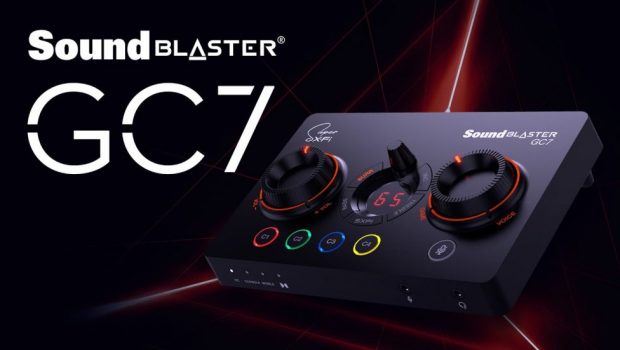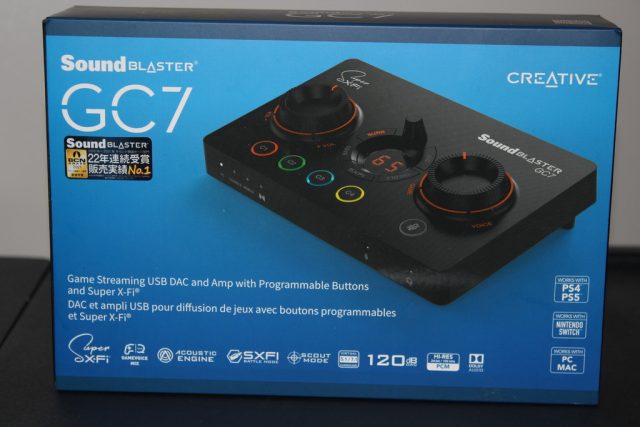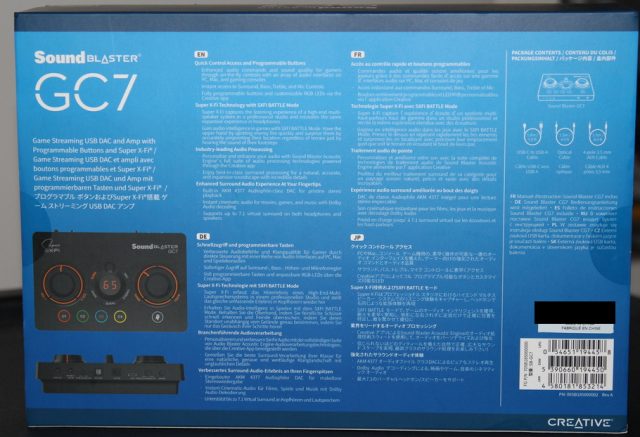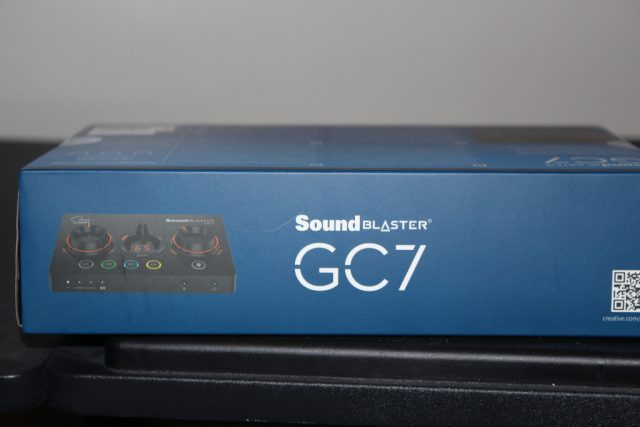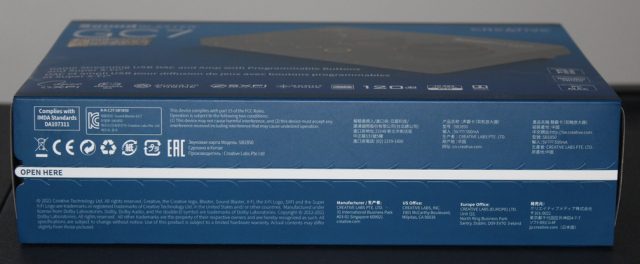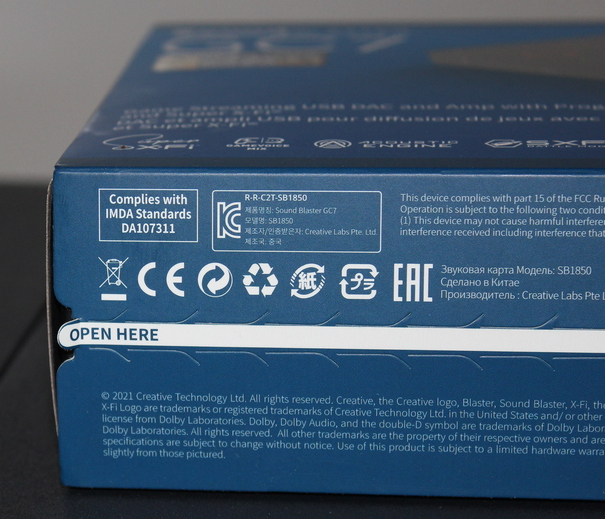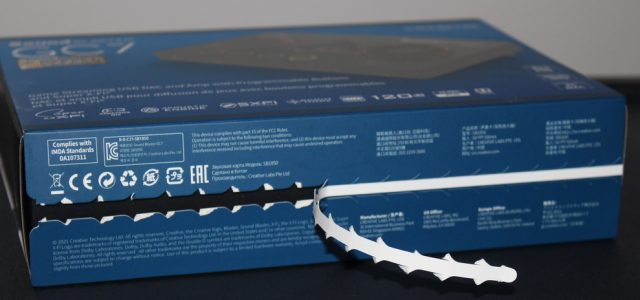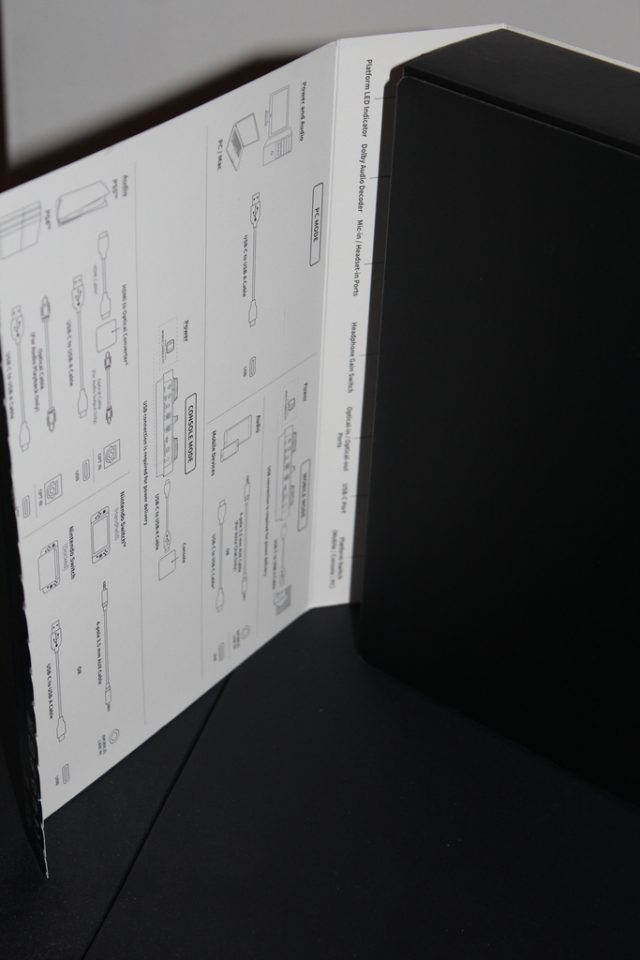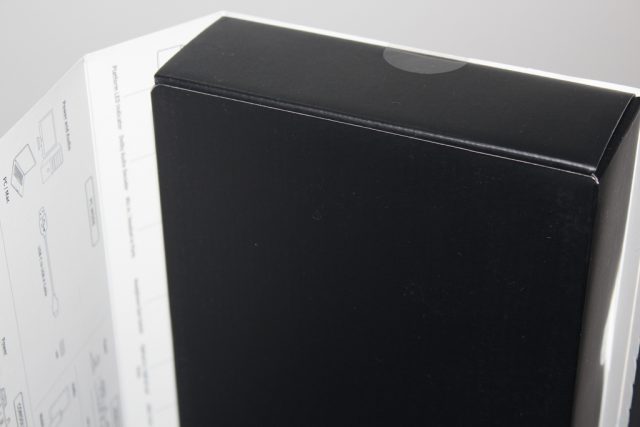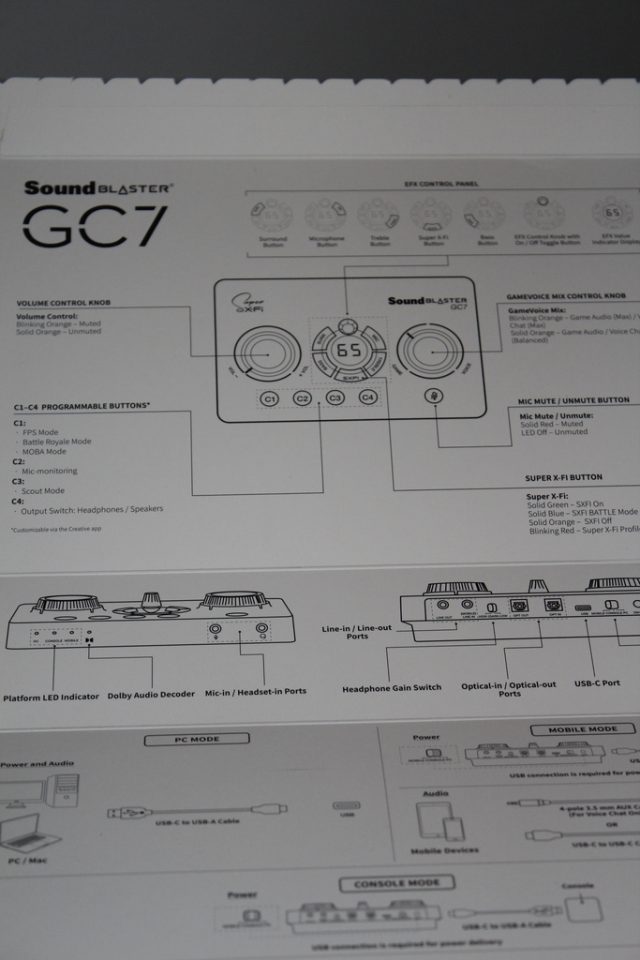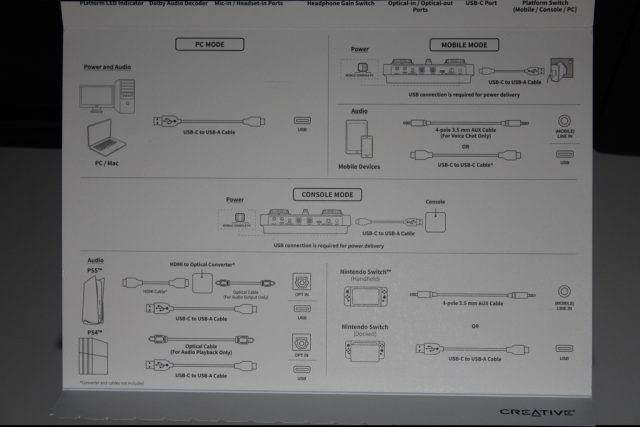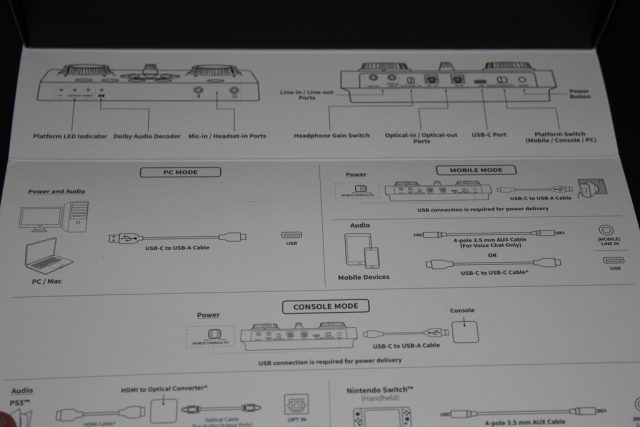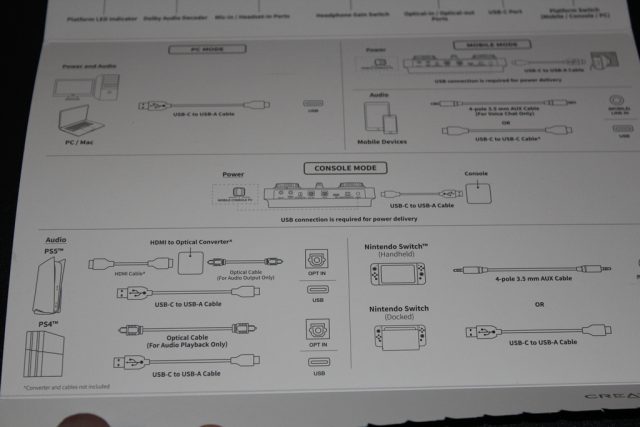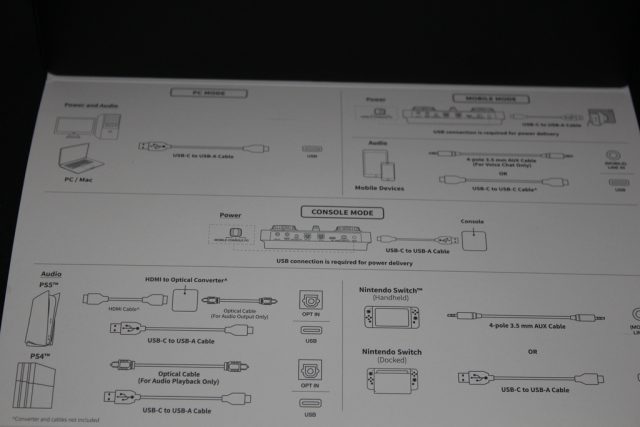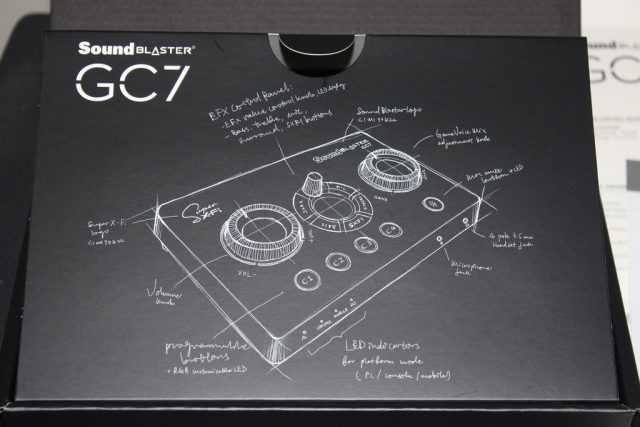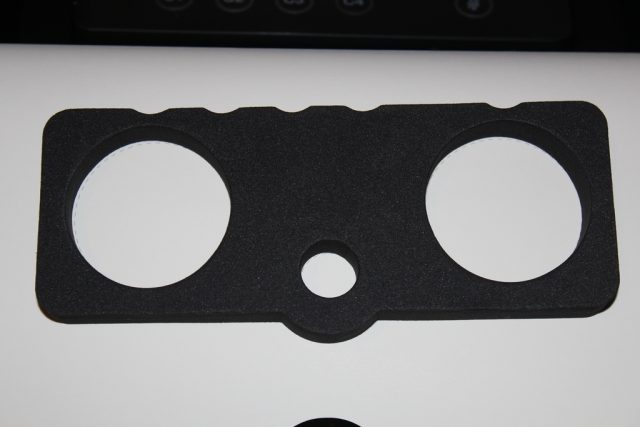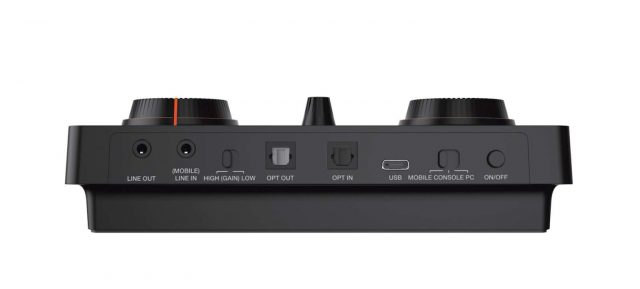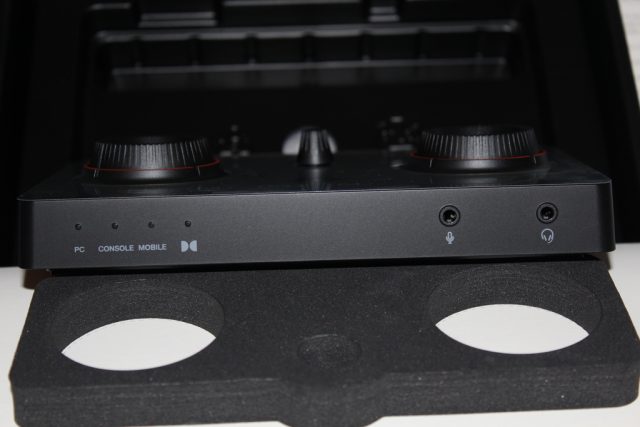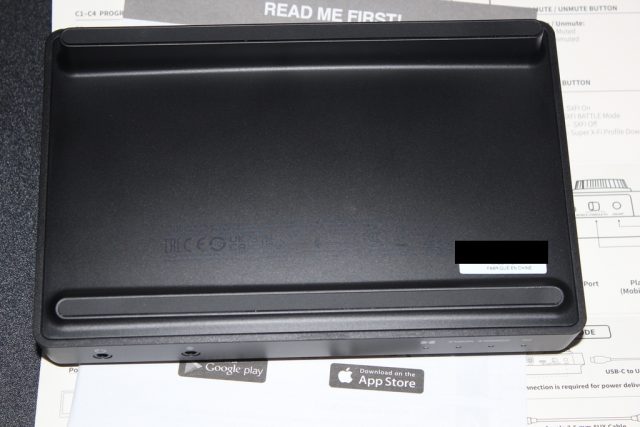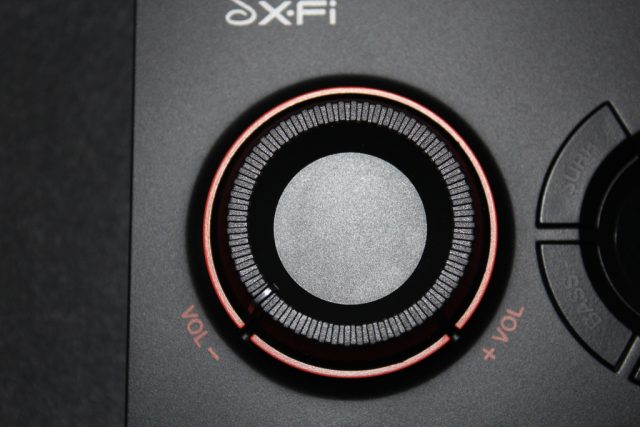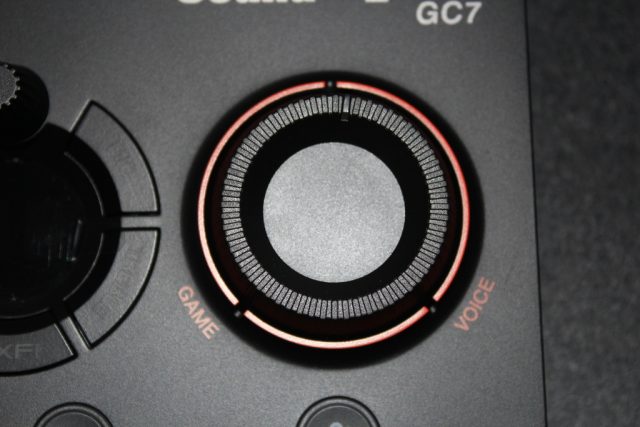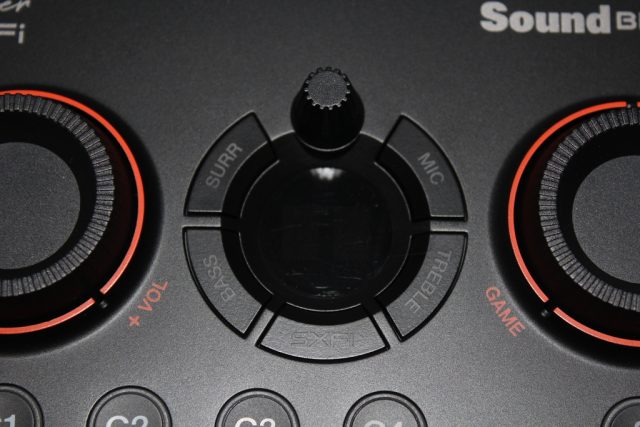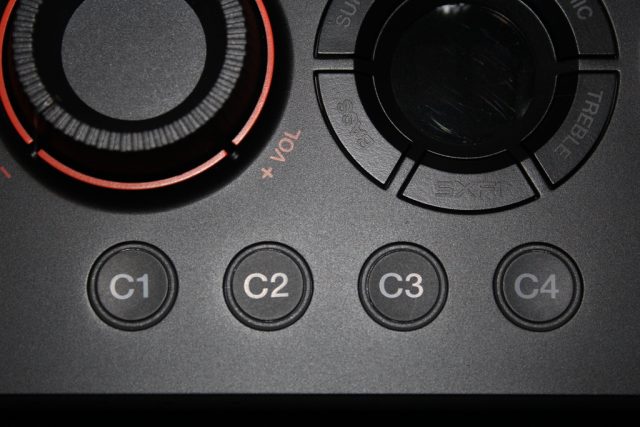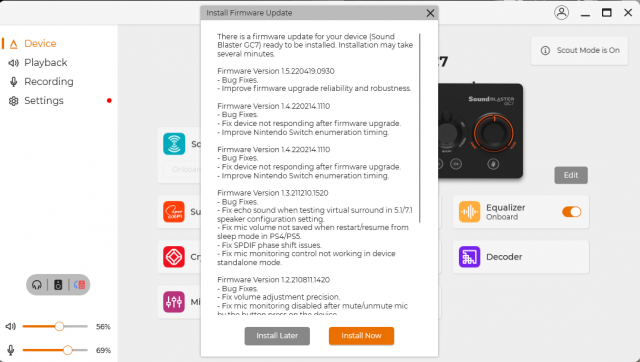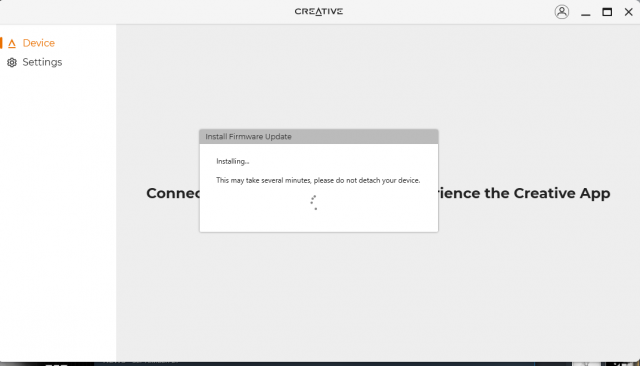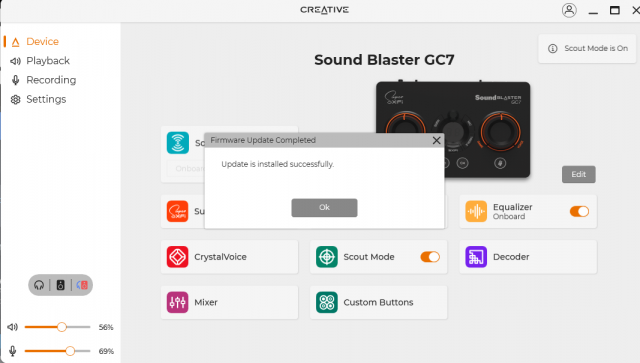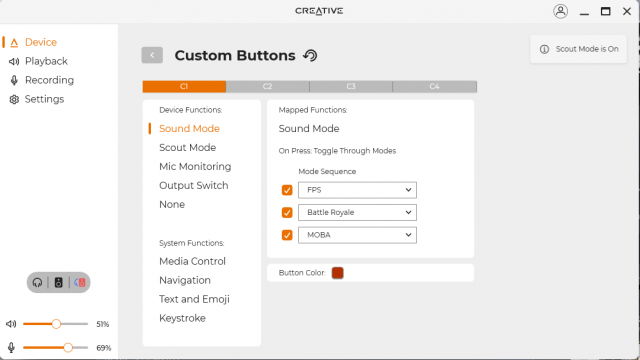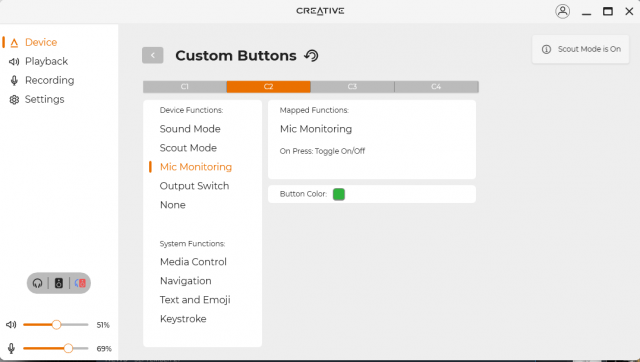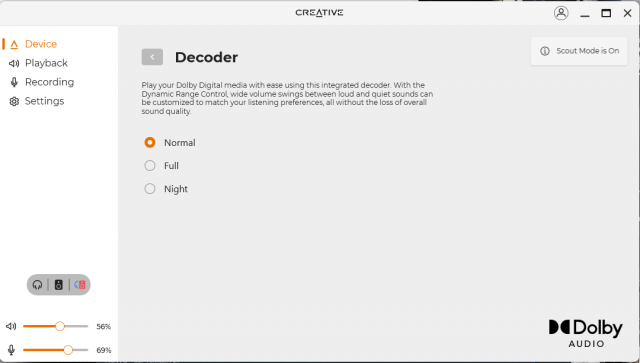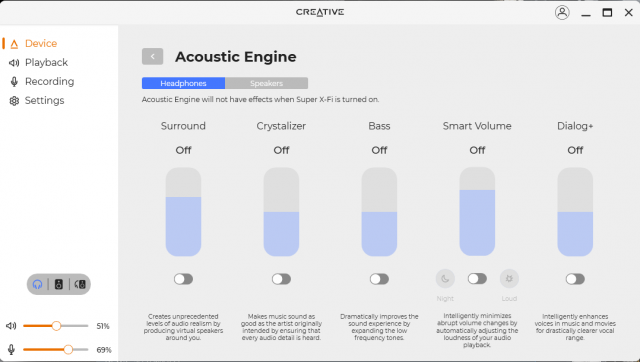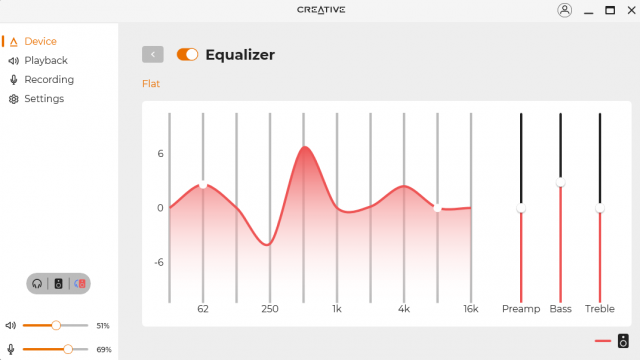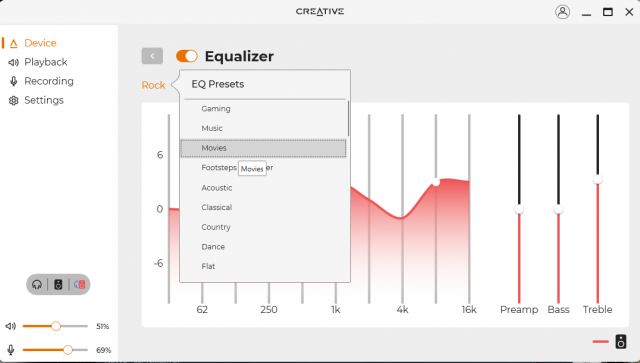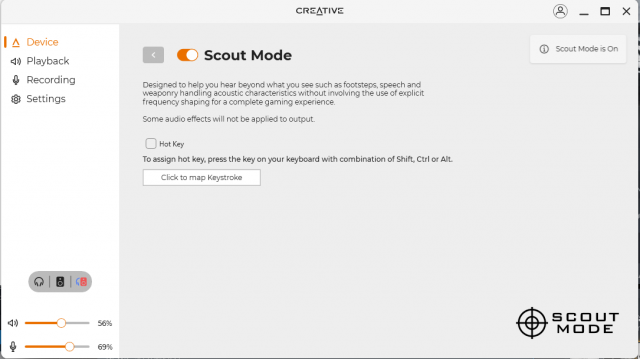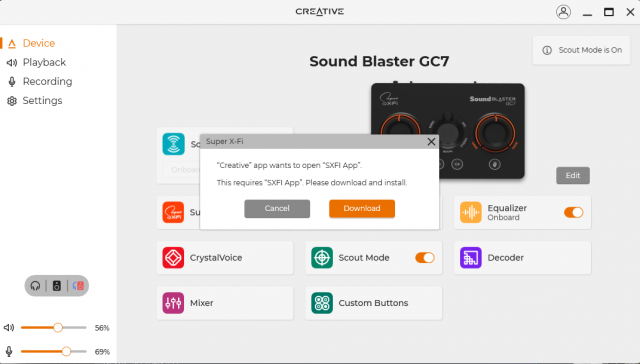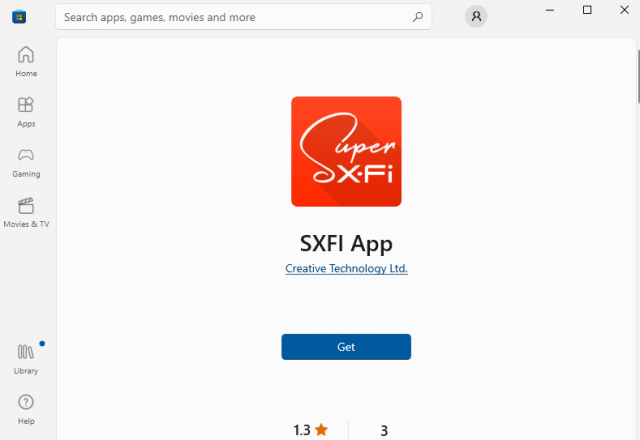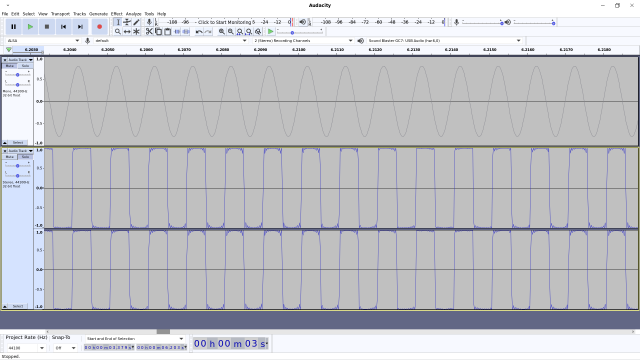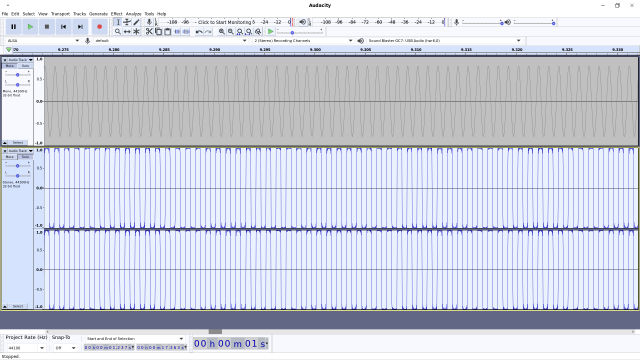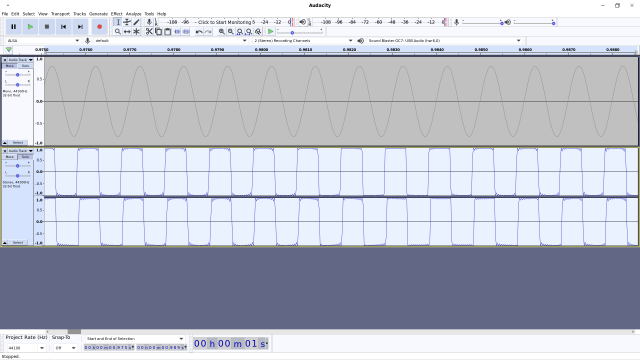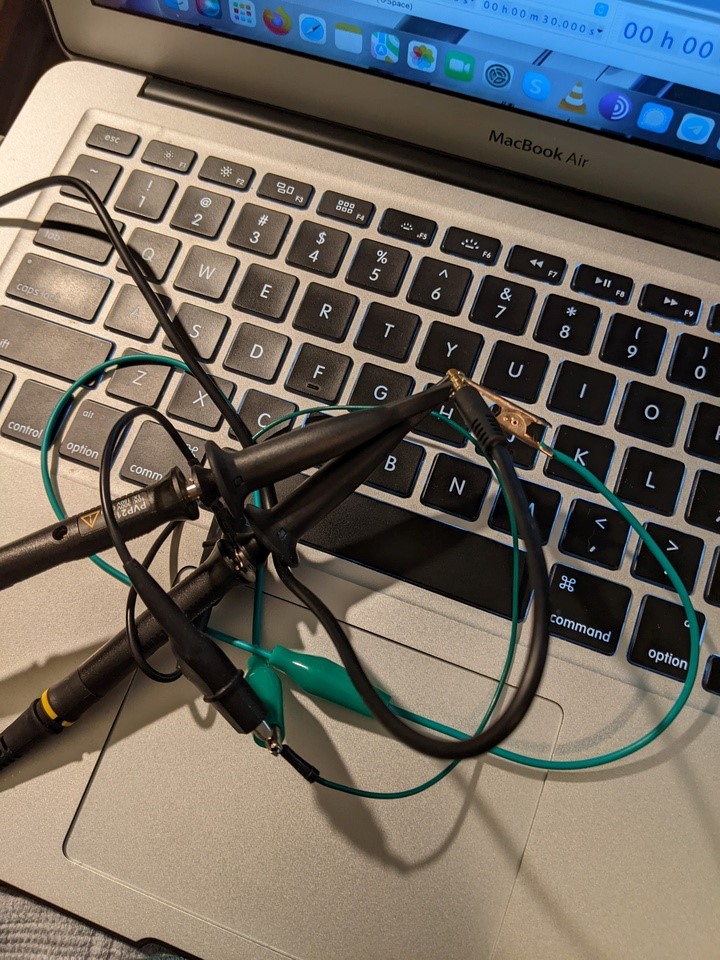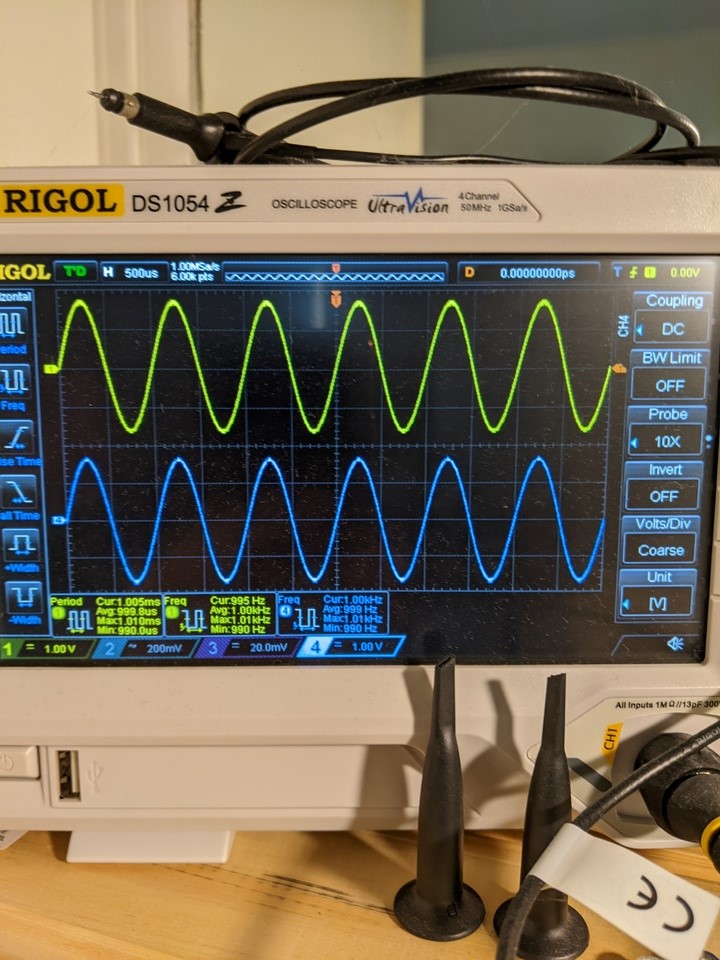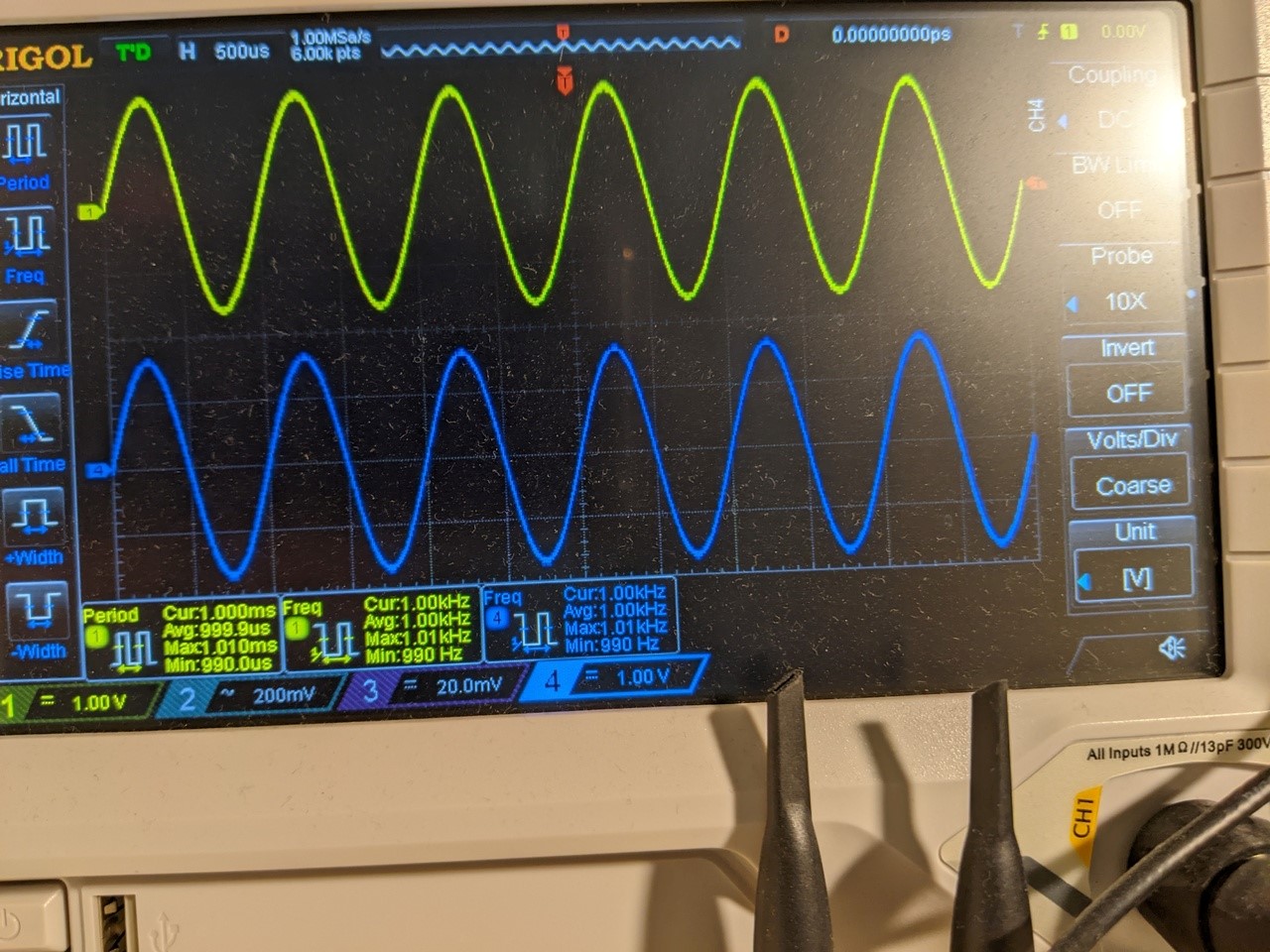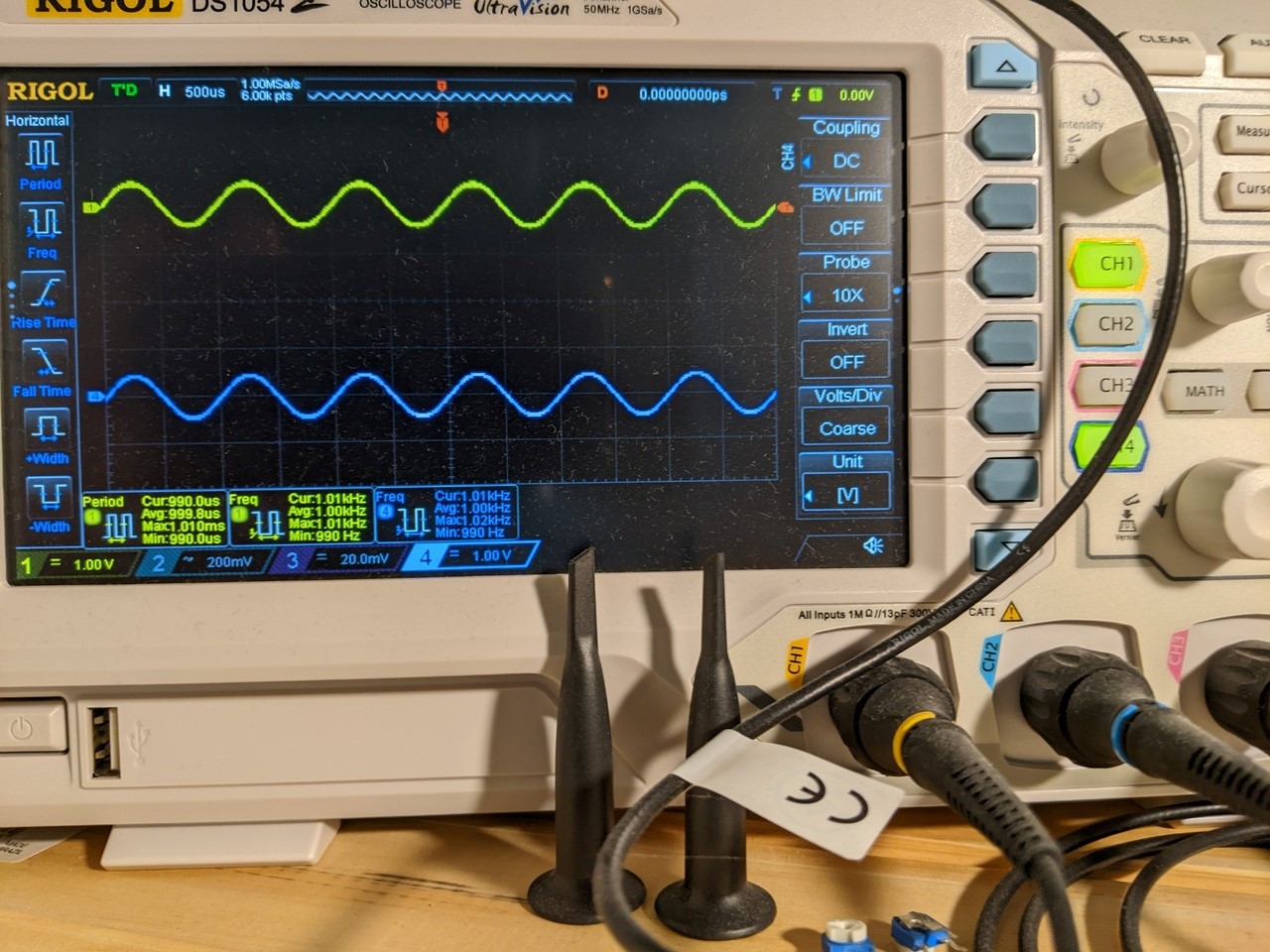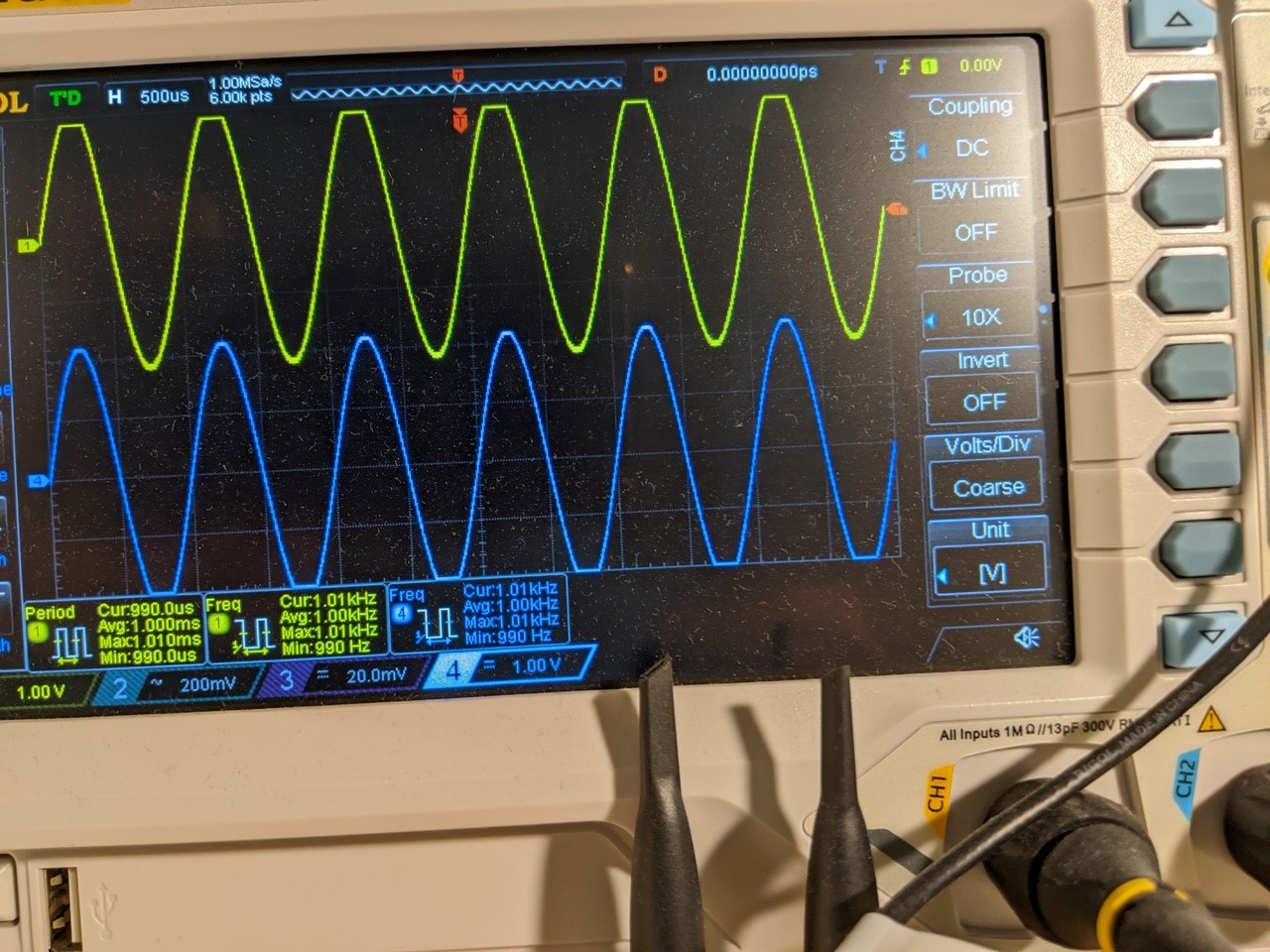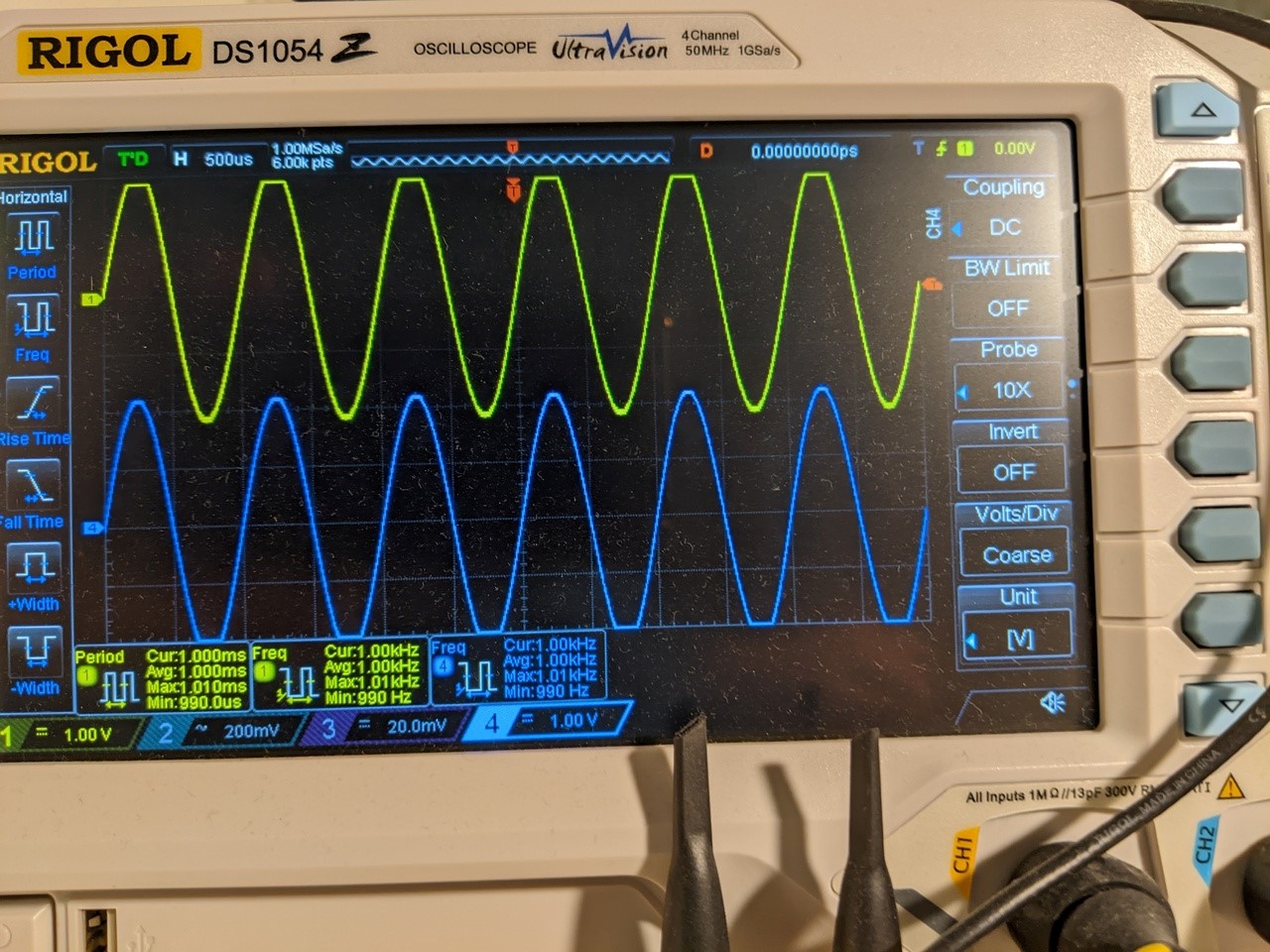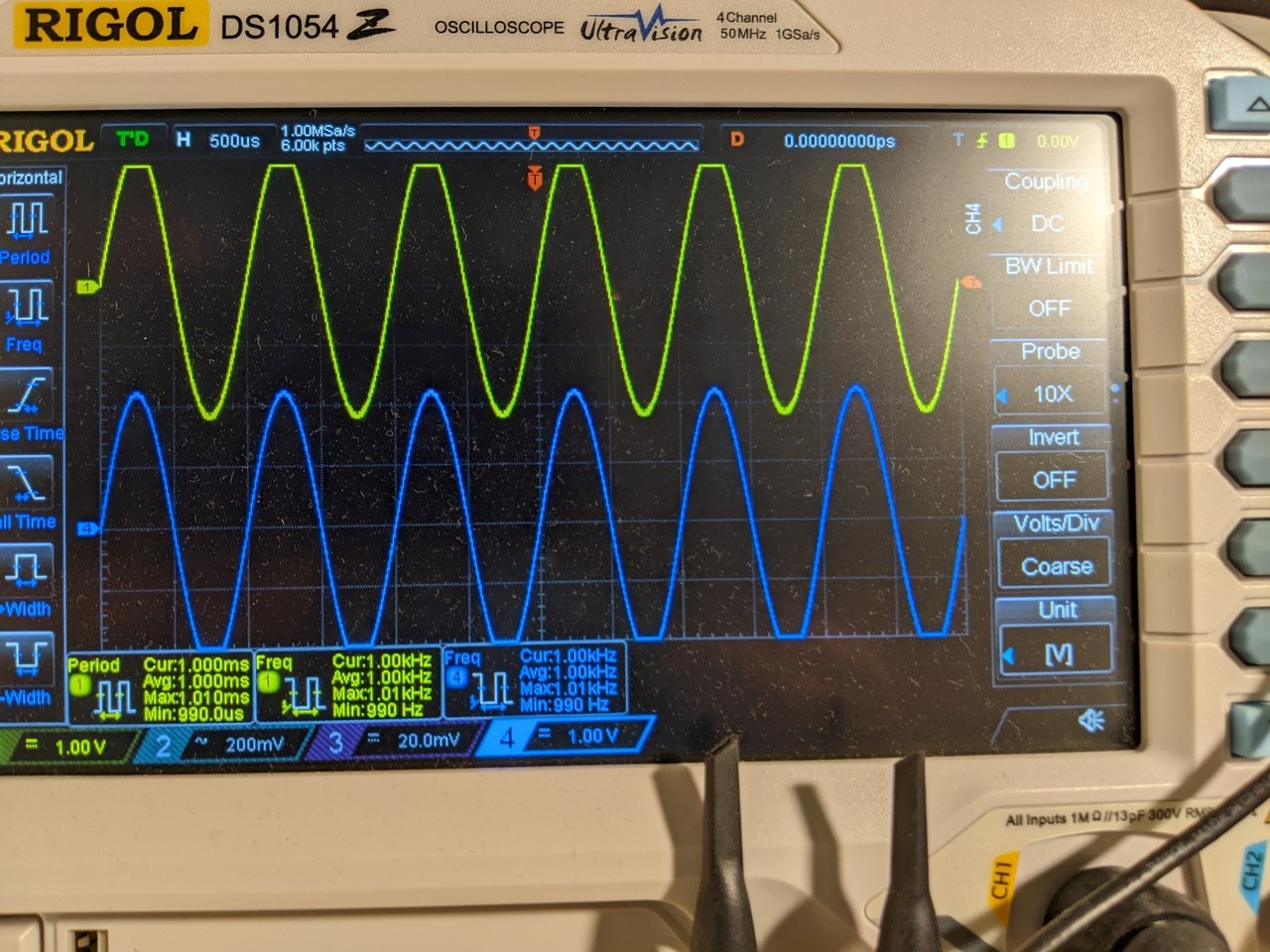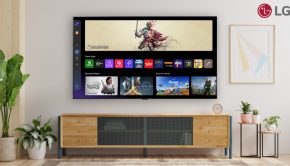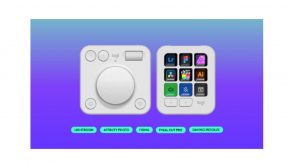Creative SoundBlaster GC7 Review @CreativeLabs @CreativeLabsAU
Take a break from tweaking your video card and graphics settings for a moment and consider your sound device and audio settings.
The Creative Sound Blaster GC7 is a dual-DSP sound DAC that is controllable from your finger tips and provides four programmable software buttons that allow you to transition between advanced audio profiling live during gameplay.
Okay so what? What will it do for me that I don’t already have?
Firstly, consider that the GC7 provides you with a portable external sound DAC that will give you a consistent and reproducible audio experience that you can take from one platform to another.
Your gaming audio can now be facilitated by a hardware agnostic device, where upon you can switch between your console and PC by sliding a switch.
How many times have you had to wrestle with audio drivers, or differences between your console and PC? And how often do you have to unplug your headphones and switch them out between devices?
It actually makes a lot of sense to consider the Creative Sound Blaster GC7 as a complement to your setup, one that you can take anywhere, use with any compatible device, and as a fully supported hardware device, eliminate needless transitions from one audio device to another.
The specifications are quite detailed and we have a lot to discuss, so head on to the product website to view the specifications and the promoted features.
Unboxing and first impression
Presented with an inner box and sleeve, the first thing you notice other than the graphics is the delightful rip tab. Although it may throw you at first, its great because this gives you 100% confidence that the box has never been opened.
The sleeve is firmly bound to the inner box, so it will not slide out until the tab is ripped.
When removing the tab and lift it up, unexpectedly we see a comprehensive reference guide, showing all of the controls, connections and operational modes.
Annoyingly, but absolutely welcomed, the box itself has each side secured with tape, which would need to be peeled or cut to prize the GC7 from it.
Once opened, you are greeted with another artistic inspired reference sheet. It really gives this impression that you have purchased a hipster inspired, exclusive and sought after product that only the cool kids will possess. Then you lift out the cover, feeling the weight underneath to see that it has a protective foam topper for the GC7.
And there it is, in its majesty, glistening, absorbing and refracting the light in equal measure. The feelings at this point was.. well have you ever opened and taken a really expensive studio microphone out of the case? Or sat in a Ferrari for a few minutes? It is that mixture of something a bit naughty with an impressive innate understanding that you are in the presence of quality.

Protective plastic covers the SoundBlaster and reminds you that you are the first person to touch it.
Of course the first thing you will do is play with the potentiometers rotate and push the centre knob and action all of the buttons – which of course is plenty of fun, but revealing. Smooth travel, no uneven clicking or bounce in the buttons, and instantly expectations are being heightened.
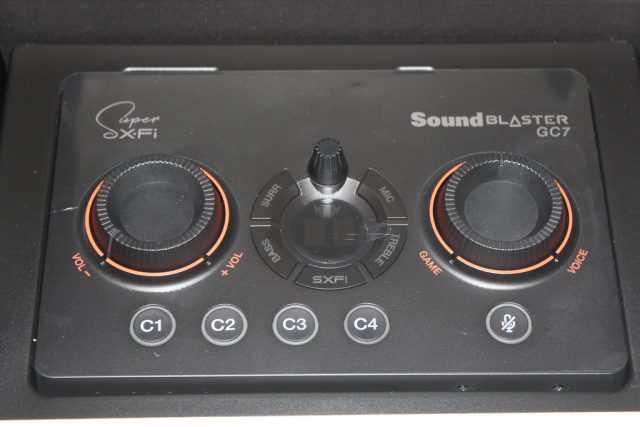
You can probably make out the 2x 8 segment LEDs in the middle. (Yes 8, because there is a dot underneath each one!)
Removing the GC7 from its cradle and looking it over, there are a few things that are perhaps detractors. The weight does feel a bit on the light side, which admittedly was expected, but sometimes you do want a bit of weight in these products just so it can let you know its there.
Rotating it around you do see the I/O and switches have clear labeling, but the USB-C, mode switch and power button are all clustered together, which looks rather odd. It is as though it was hastily shoved in there.
The long rubber tracks on the bottom are quite strong and will not simply peel off after time. On a desk they reduce friction and movement but don’t stop it entirely. Feeling the edges of these tracks, there is likely case screws being concealed there. If so, this is truly a good case design because you don’t see any ghastly screw holes or seams.
The included cables are all of acceptable (but cheaper) quality, but may be a bit on the short side for some, especially the optical cable, in fact its short enough that you could come to the conclusion that you aren’t really expected to ever use it.
Controls and design
The controls are best explained thus:
There are “three sections”, the two large knobs on the left and right respectively:
The smaller control knob, and five buttons.
And on the bottom we have the mute button and four programmable buttons.
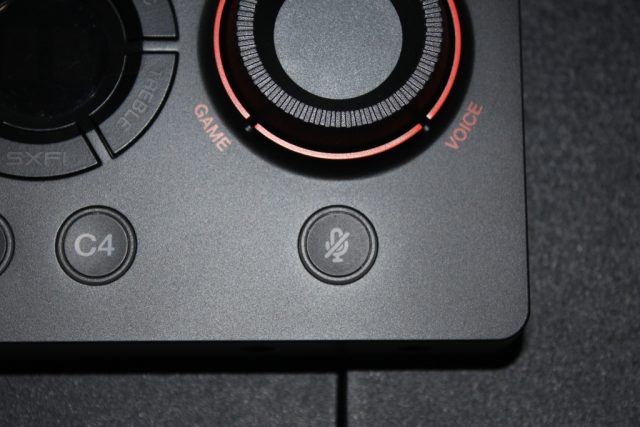
Non-programmable mute button. Sets the mic input value to 0 and enables when mic input is dialed to 0.
The volume knob on the left is self explanatory, but the right is a bleed switch that takes the audio output from the PC/Console/Phone, which is received into the GC7 via USB or line-in as an audio input on the left, and on the right, the microphone which is the 3.5mm microphone input jack. The audio selection can be the ‘GAME’ audio channel, or just the microphone or a blend of both.
This is perhaps confusing for the uninitiated, as what you are controlling here is your monitoring mix and volume, specifically what is audible through your line out/headphone output.
The middle section is where the magic happens. Depending on the operational mode and software settings, you can customise your sound by directly selecting the Bass, Treble and Surround buttons and dialing the parameter up or down with the control knob. Each of these parameters can be set to the default setting by pressing down the control knob which is also a select button.
Of course, perhaps its humour that they made the mic preset “69”! Yes we see what you did there.
When changing controls the effects are observed immediately, and there are no convoluted press and hold or long drawn out sequence to operate, which free’s up the gamer for more important things, like gaming.
Each of the software buttons can be configured to taste, including the LED, which makes operating much more intuitive as you can associate buttons with functions or presets.
The main potentiometers have hard limits and so these give tactile sensation to the operator, meaning you wont need to divert your attention away from the screen, but can operate the core functionality by touch alone. The fact that the mute button is off to the side and directly under the bleed control is a nice touch, because again, this can be found by feel.
Overall the design is well thought out, minimalist and apt towards a gaming control. The angle of the deck is also similar to a keyboard and would work perfectly just sitting above the mouse pad or on the left (advisable for most games) of the keyboard. A fast transition to the controls and back to the keyboard is possible.
The design is very similar to how a guitar effects pedal may look and feel, and what comes to mind is something that Zoom Corp would make. Creative have done an exceptional job with the design and layout.
Software
Windows will detect the GC7 immediately and attempt to install the sound card drivers. It will present as the GC7 speaker, headphone and microphone devices, all of which detect at the compliant capabilities as advertised.
The software is available on Creative’s website and after a short download, the installation is a straightforward matter.
What we found was that there was a firmware update which was immediately available, and the list of fixes and enhancements were comprehensive. Suffice to say that GC7 behaved better after it was installed.
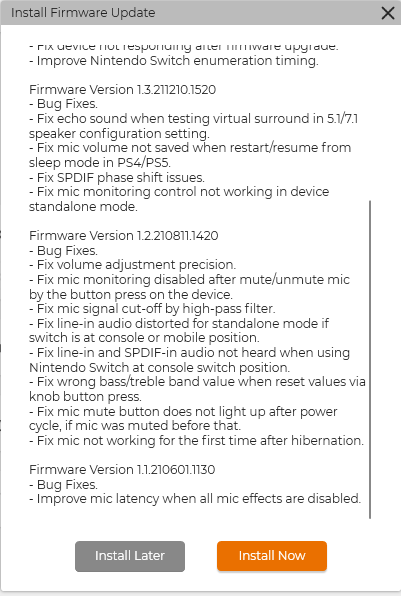
Quite a lot of updates were pending, spanning multiple versions. Needless to say that some of these bugs were present until the update was installed
As mentioned, the software buttons are fully customisable, so you can change the LED colour and the associated function, which can be set to the device functions or even some media control functions in Windows.
The software allows you to pass through your dolby digital sound to the GC7 to offload the decoding, as well as tweaking the EQ by presets and by selecting and dragging the frequency scale as required. Now yes you can often do this within the game and with software, but this is adjusting it on the GC7 directly, which allows you to alter the characteristics of the audio significantly.
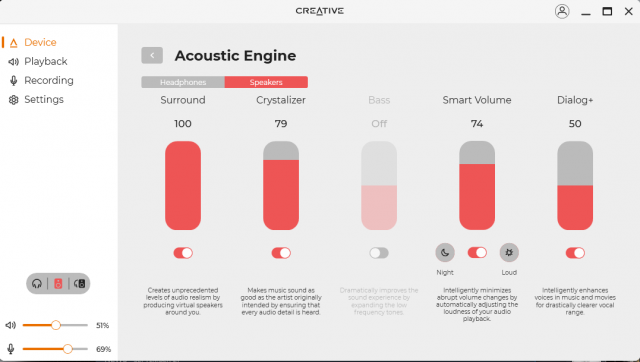
Note the icon on the bottom left: This is the EQ in Speaker mode. These values are represented and controlled by the centre buttons
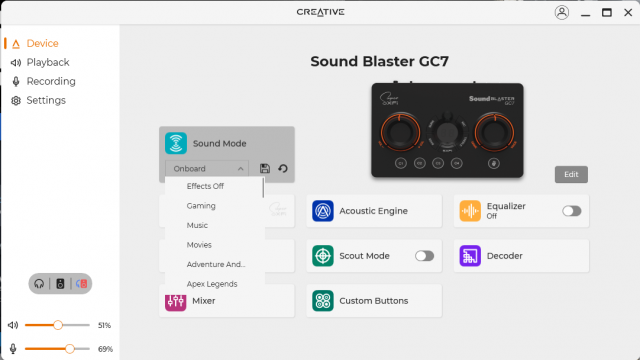
You can select the modeling to use from the main screen. Yes that is a scroll bar, there are quite a few out of the box!
Now you have Scout Mode and the Acoustic engine and all the other fancy elements. What you need to know here is that this is all achieved by the built in DSP and ultimately it is dynamic range and frequency manipulation. Not all games will gel well with this, especially older games where the audio dynamic range may simply be lacking, or where the audio frequencies being enhanced would make the audio sound artificial. It comes down to experimenting.
The SFXI capabilities will enable the GC7 to use modelling for your headphones so that the guesswork is taken out of the equation. Using this feature with the SFXI application from the app store, will let you use a pre-made profile that suit your headphones with the GC7, so that all of the EQ and advanced options are set to provide the best gaming performance possible. This is also paired with the game or audio mode set, such as “gaming” “music” and specific titles.
This is ultimately subjective, because often with presets, either its a winning combination or you will feel the need to tweak. If you care enough, you are simply going to tweak anyway so it is best viewed as a good head start – and only if your headphones have a profile.
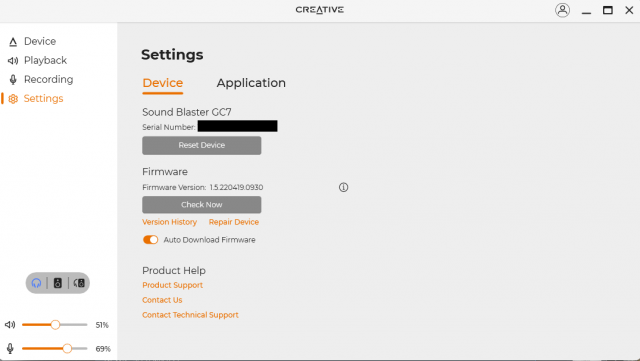
The software also allows you to reset the firmware and automatically keep it up to date. This is a great feature.
The software is great, it does exactly what it says it will do and doesn’t push anything else down your throat.
Audio Analysis
Don’t worry audiophiles, we got you!
Using Audacity, a 1kHz tone was generated at 0.8 amplitude and this was pushed out via USB and captured again via the the PC sound card analog input.
This was quite interesting, what you can see here is some noise and ripple on the peaks which were audible in the playback. What was more concerning however was some form of noise that had quite a bit of structure to it, without any audio passing through.
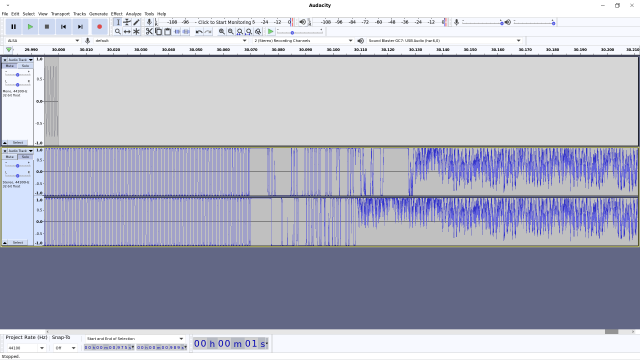
SFXI was blue – meaning battle mode enabled. the top track is the 1kHz sine wave, which trails in the recording for longer than it should, but also it eventually degrades in structure before becoming noise.
Was this ground loop from USB and ground reference over the audio cable? Possibly, but we would expect 50Hz hum, whereas this had structure. It seemed like there was a software element to this as the structure of this waveform followed the previous frequency before trialling off randomly.
Now this just did not make sense, because under normal circumstances the playback audio is clean. Suspicious as to the cause, a quick test of the gain switch between high and low does in fact alter the audio and the distortion and structure is reduced with low gain. That makes sense because the circuit bleeds the microphone back into the mix.
Some of you at this point will be screaming “Ground loop”, some may be suggesting it is RF from the 3.5mm cable, and the electronics aficionados may say its a noisy Op-Amp. Either way, it was odd since the sound card in the PC is clean on its own and we believe the GC7 is producing a clean output also. Well, lets change the outcome by measuring it!
Using the Macbook on battery power, with audacity providing a 1kHz sine wave at 0.8 amplitude, and the supplied 3.5mm cable, we pushed out the audio via the USB interface and captured the line-out/speaker output. The GC7 volume was at 100% SFXI was off and manual EQ were at the lowest settings, including surround at 0.
Sorry for the photos, but a spare flash drive wasn’t handy to capture images off the scope!
Everything was as it should be, both channels were captured, both were consistent and uniform and most of all, no noise or artefacts were seen. In fact, you could – and we do, say that the output was perfect and matched the sine wave we put through it.
Dropping the volume on the GC7 to 50% also kept the integrity of the sine wave. There was no phase shift, deviations between channels or anything of concern.
Increasing the EQ settings to the top end of the range and bumping up the surround a bit, started to push the amplitude outside the capture range of the scope; which means that there is a ‘volume increase’ as these settings increase. What was interesting though is the top end seemed to flatten the positive peaks whilst the bass seemed to affect the negative peaks more.
In real life, don’t worry about this. You may notice a bit more ‘oomph’ to the sound with the highest EQ settings but we are only talking about a few mV of difference.
Since the scope was already connected, why not capture the switch bounce? Sure!
Turning off:
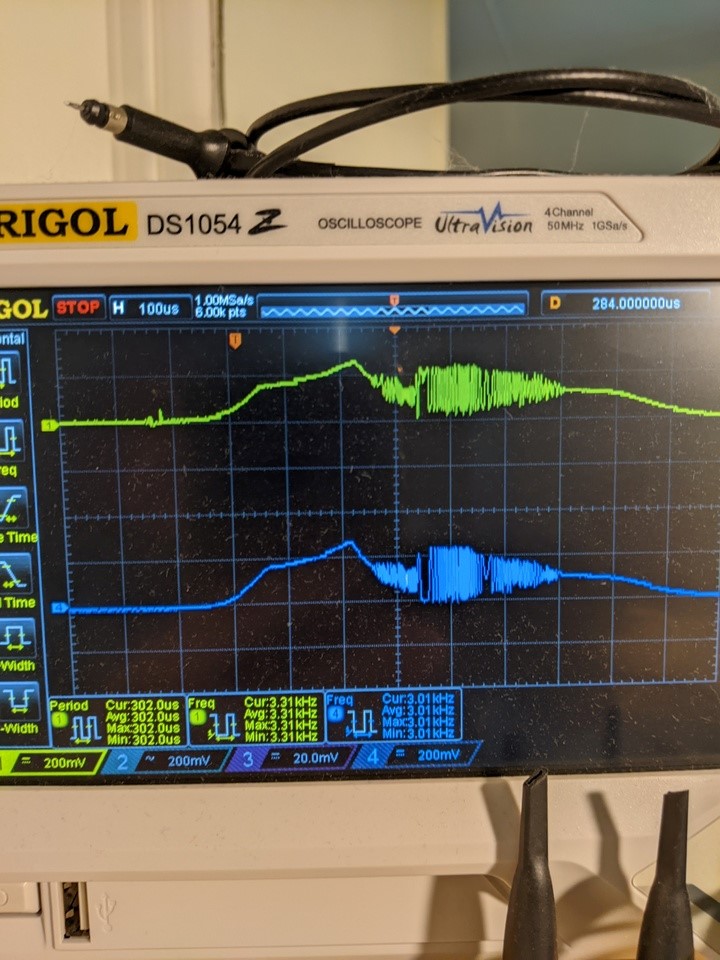
Spanning 800us @ ~200mVpp. It isn’t quiet, but it’s not that bad! So quick you wont notice.
Turning on:
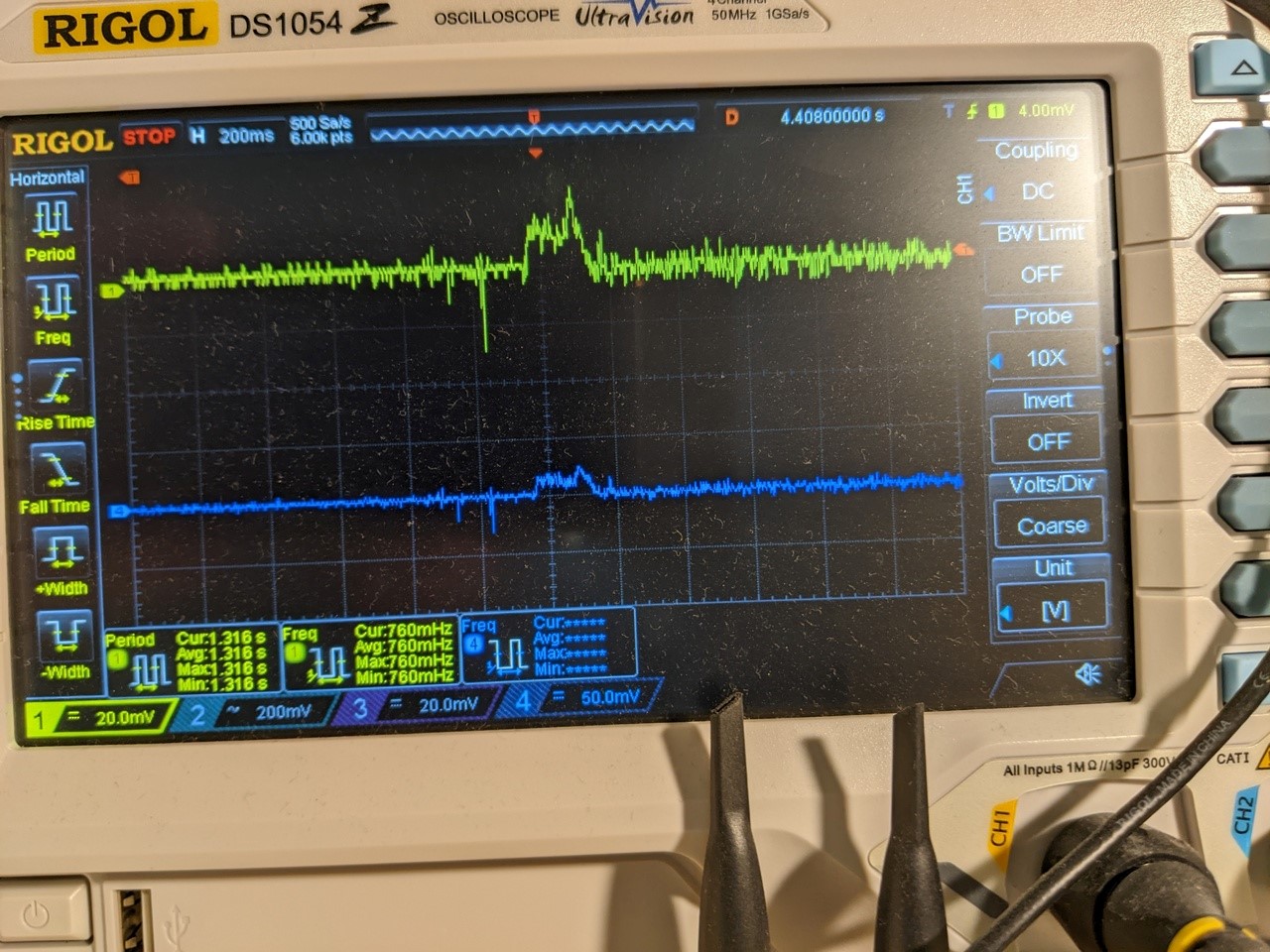 Barely 20mVpp for ~200ms. You wont notice it at all
Barely 20mVpp for ~200ms. You wont notice it at all
Looks like turning it on is a quiet affair, it was even difficult to capture it. Turning it off however, well that is enough to produce a ‘thud’ sound in your speakers, with a higher voltage change for a slightly longer duration. Of course it really does depend what load you have connected and where the discharge will go, you may not hear a thud at all – but don’t worry about it, it’s quite normal, and the GC7 is not going to blow up your headset or speakers.
Yes you may get a lot of noise and problems if you attempt to rig some convoluted audio loop between your PC and recording sound devices, but in all fairness, that is not the intended purpose of the GC7.
It would appear that the GC7 indeed has a clean analog output and is capable of reproducing the digital input stream as a true representation. As a sound card for your PC or Console, you will be hard pressed to find a better result.
Game testing
There was only enough time to test out two games prior to writing this review. It’s a shame because there are so many games that would benefit from this DSP enhancement.
The first game was 0AD, which if you are not already aware of this open source game, you should check it out. Being a strategy game, it has a constant background track of ambient sound, alerts and triggered sound events when buildings are finished, resources are attacked and units are interacted with.
It was in 0AD that the first 20 seconds of enabling the surround sound that a tremendous improvement was not only heard but also felt. It really did feel like the game audio went from a flat front of field stereo, to a full immersive 360 degrees surround experience. Moreover, the directional aspect of the sound was greatly enhanced, so much so that the sound aided the map movement, allowing you to move to where you ‘hear’ the sound with far greater accuracy.
There is a lot of marketing and hype around the 1st person shooter games, which is all well and good, but if you like a nice strategy or even a cinematic RPG, you will find that the audio is likely going to be greatly enhanced with the simplest of tweaking.
The second game was Arma III, which was chosen because it is a well established first person shooter which also has some questionable audio issues from time to time. The thinking here is that it would be a good test to put the Creative GC7 through the paces and we would determine what the effect would be on the audio, good bad and ugly.
After several hours of game play and completing about half of the campaign, several sound modes were tested and observations were made. In many respects the sound was enhanced, especially the footsteps and squishing of the leaves underfoot, however where there were gains there were some terrible losses.
Firstly, the ‘right setting’ was difficult to pin down, this was in part because of the learning curve with respect to the finer settings, and also because the games original audio is just so inconsistent. Manual control of the EQ and surround seemed like a step up until the upper limits of surround were dialled in, which instantly made the air-presence, the upper sounds above 4kHz to sound artificial and grated against the ear.
Enabling the Battle setting via the software which in turn prevents manual manipulation of the controls, also seemed to give a similar base point. There were some gains, but not so much so that you couldn’t go back to your previous setup. With Scout mode on, it was difficult to ascertain what, if any change occurred, but the feeling is that weapon reloading and sounds of gunfire were enhanced.
Large explosions and dynamic range effects were enhanced mostly in the bottom end, but during the cut scenes, all of the annoying buggy audio suddenly had enhanced and more noticeable dodgy aspects. That is to say, that you simply cant polish a turd – if the audio is terrible going in, it will be enhanced-terrible through the CG7.
With a game like Arma III, it is clear that you can make some gains in the audio and if you are prepared to actively tweak the controls during play, or perhaps toggle between presets etc, you may find that you can make some serious improvement. Overall, it is the mid range frequencies that seemed to respond the most to the preset DSP functions, which makes sense as this is where the majority of active frequencies will be and would likely experience the most change with the dynamic range manipulation.
Based on this testing experience, there is no doubt that the GC7 would perform well with a variety of game titles, including simulators, racing, shooters and of course strategy games. In fact, even movies and music would be greatly enhanced.
Final thoughts
The Creative Sound Blaster GC7 breaks through as a device capable of delivering a transformative and immersive sound experience.
Any serious gamer or enthusiast would instantly receive a boost to their gaming and entertainment experience, which they can take with them to any computer or platform.
Realistic expectations must be set however, as with all things, miracles are not included – if the audio quality in your game is terrible to begin with, then you will only get an enhanced version of the original terrible audio, which will no doubt highlight all of the original shortcomings in total spatial clarity.
When the game’s audio and spatial sound is good, then the only problem you will encounter, is that you wont want to go back to the original after hearing it through the GC7.
Summary: The SoundBlaster GC7 will improve your gaming experience and change the way you think about gaming audio. You won't want to go back to 'normal' after experiencing the GC7.


